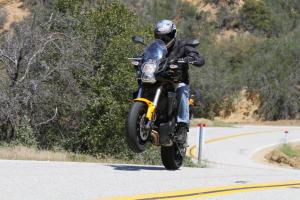2012 650 Adventure-Tourer Shootout - Video - Motorcycle.com
If you’re on the hunt for an all-in-one, Swiss Army Knife-type of motorcycle but don’t need the physical size or all the engine (or pricing!) of something like a BMW R1200GS or Ducati Multistrada, then consider the BMW G650GS, Kawasaki Versys and Suzuki V-Strom 650 ABS.
Each contender in this trio of middleweight adventure-ish motorcycles offers the qualities of a comfortable daily commuter, capable canyon carver, light-duty tourer and a willingness to wander when the pavement ends, all wrapped up in one machine. Their 650cc-class displacement should provide the majority of riders with adequate power, yet this engine size – along with a lack of high-end electronic gadgetry – also helps keep base MSRPs well below the $10K mark.
Although these bikes rarely see the limelight, we found they provide a lot of motorcycle for the price; and they differ enough from each other that each bike is sure to find a loyal following depending on their tastes and intended usage.
Three Ways to Motivate
A neat aspect of this collection is the fact that we have three different engine types all in the same displacement range. The V-Strom is still powered by a 90-degree Twin, but it’s now using a recently revised version of the 645cc mill put to service in the Suzuki Gladius. The Kawasaki’s heartbeat comes from a 649cc parallel-Twin – the same engine it has used since the bike’s inception – while the BMW operates with a 652cc Thumper (single cylinder). Each bike is fuel-injected as well; the G650GS uses a five-speed gearbox where the other two are six-speeds.
Associate Editor Troy Siahaan thought the BMW’s five gears were “decently spaced to outrun traffic,” but as E-i-C Kevin Duke noted in his single-bike review of the 2011 G650GS (virtually the same as the 2012 model), the “transmission’s low ‘granny’ gear runs out quickly, requiring early shifts up to second.” Despite well-planned gearing, there’s no denying the littlest GS’s power deficit.
In a world where 150-hp sportbikes are common fare, the peak rear wheel horsepower of the Suzuki, Kawi and Beemer barely register on the horsepower Richter scale. But the G650GS is notably behind even in this small crowd of “low” horsepower motorcycles.
As you can see in the set of dyno runs provided by Carry Andrew of Hypercycle fame, the BMW’s Single is simply outgunned. At a tick less than 42 peak horsepower at 7000 rpm the G-GS is a full 14.5 hp off the pace of the Versys, and it suffers a considerable gap to the Suzi’s commendable 63 ponies at a comparatively high 9000 rpm.
With the exception of a small low-rpm dip, the GS hangs tough with the other two throughout the midrange until it begins to run out of steam around 6000 rpm where the Kawasaki and Suzuki keep spinning up. What we shouldn’t lose sight of is that despite an overall poor showing in peak horsepower, the GS provides sufficient power in rpm ranges where riders will spend the majority of time. A potentially unappealing trait in the GS’s mill is a noticeable amount of clackity-clacking from its top-end.
The story told in the torque dyno graph reveals the BMW doesn’t suffer to the same degree as it does in the horsepower race – only 5 ft-lbs of peak torque separate the GS from the strongest-of-the-group V-Strom, with the Versys splitting the difference.
“The BMW engine is relatively smooth and provides easy-to-use Thumper torque when riding slow, single-track encumbrances,” says Content Editor Tom “T-Rod” Roderick.
Nevertheless, by virtue of its design the BMW is a busy-feeling engine when keeping the Thumper spinning while rowing through the gearbox. The Versys, too, exhibits a buzzy-ness as a result of its Twin’s parallel layout, but while street riding, the GS’s vibrations are more prevalent compared to the Kawi, and likely why BMW installed removable vibration-damping rubber inserts in the G650GS’s footpegs.
With two cylinders and a nearly identical displacement to the V-Strom, the Versys engine gives the Suzuki fits until approximately 6000-6500 rpm when the ‘Strom’s engine continues its upward climb while the Kawi tapers off.
Stretching the Kawasaki’s throttle cable in order to squeeze every drop of power from the upright Twin while running through the gearbox masks the Versys’s otherwise uninspired acceleration, particularly when in top gear. “The Versys’ engine feels just as busy at 5,500 rpm as it does at 10,500 rpm,” notes Tom.
If you’re into entertainment value as much as anything from your motorcycles, then you might willingly overlook the Versys engine’s perceived flatness Tom mentions, in exchange for its eagerness to wheelie – even from second gear with a little encouragement from a loaded clutch. Speaking for myself here, but that quality carries a lot of weight – I loves me some wheelie prowess.
So then we come to the Wee Strom, the motorcycle with the engine which not only possess the most power overall, but is the smoothest in any gear at any rpm, cruises effortlessly at 80 mph-plus, has flawless response from the EFI and provides the “most user-friendly power with an accessible torque curve,” according to Troy. The harmonically balanced V-Twin is a dream, as it’s almost impossible to sense engine vibration in the pegs, handlebars or seat.
Let’s face it; although these motorcycles have the capability to ride off-pavement, the majority of their miles will spool up on the street. And when you’re droning the freeway or constantly clutching your way through traffic, a smooth, quiet engine – that’s also muscular and manageable – is an enjoyable asset.
We found things to admire about each engine, but in the end a clear consensus emerged that gave the V-Strom a Best Engine vote across the board.
More by Pete Brissette
































Comments
Join the conversation